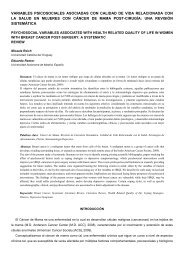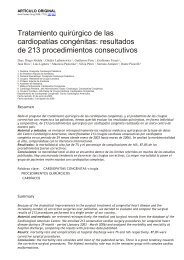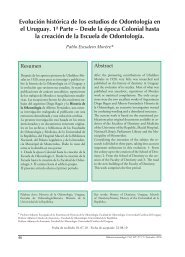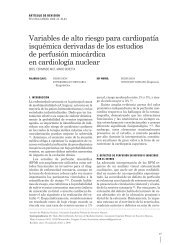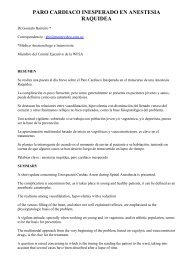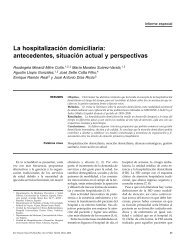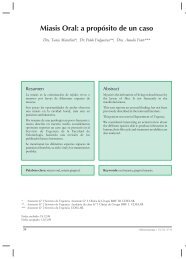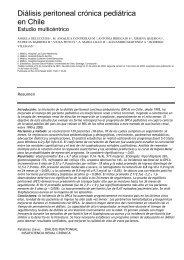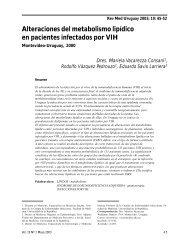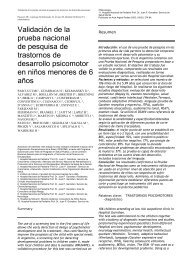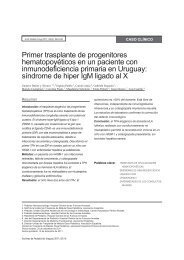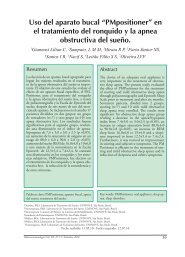Factores de riesgo para muy bajo peso al nacer y peso al ... - SciELO
Factores de riesgo para muy bajo peso al nacer y peso al ... - SciELO
Factores de riesgo para muy bajo peso al nacer y peso al ... - SciELO
Create successful ePaper yourself
Turn your PDF publications into a flip-book with our unique Google optimized e-Paper software.
Agra<strong>de</strong>cemos a la Dra. Gloria Mendoza <strong>de</strong> la Unidad <strong>de</strong> Perinatología <strong>de</strong>l Banco <strong>de</strong> Previsión Soci<strong>al</strong> y <strong>al</strong> Dr. Rodolfo Vázquez<br />
<strong>de</strong>l Centro Hospit<strong>al</strong>ario Pereira Rossell por la posibilidad <strong>de</strong> acce<strong>de</strong>r a los datos institucion<strong>al</strong>es y <strong>al</strong> equipo informático <strong>de</strong>l<br />
CLAP (Ing. Franco Simini y Luis Mainero) por su ayuda en la construcción <strong>de</strong> la base <strong>de</strong> datos utilizada en la investigación.<br />
AM y CAF recibieron una bolsa <strong>de</strong> estudios <strong>de</strong> maestría <strong>de</strong> CAPES/Brasil.<br />
Bibliografía<br />
1. Kliegman RM. Fet<strong>al</strong> and neonat<strong>al</strong> medicine. In: Behrman RE, Kliegman RM, eds. Essenti<strong>al</strong>s of Pediatrics. Phila<strong>de</strong>lphia:<br />
WB Saun<strong>de</strong>rs, 1994: 157-213.<br />
2. Furman L, B<strong>al</strong>ey J, Borawski-Clark E, Aucott S, Hack M. Hospit<strong>al</strong>ization as a measure of morbidity among very low<br />
birthweight infants with chronic lung disease. J Pediatrics 1996; 128: 447-52.<br />
3. Saig<strong>al</strong> S. Follow-up of very low birthweight babies to adolescence. Semin Neonatol 2000; 5: 107-18.<br />
4. Wilson-Costello D, Borawski E, Friedman H, Redline R, Fanaroff AA, Hack M. Perinat<strong>al</strong> correlates of cerebr<strong>al</strong> p<strong>al</strong>sy<br />
and other neurologic impairment among very low birthweight children. Pediatrics 1998; 102: 315-22.<br />
5. Finnstrom O, Gaddlin PO, Leijon I, Samuelsson S, Wadsby M. Very-low-birth-weight children at school age:<br />
aca<strong>de</strong>mis achievement, behavior and self-esteem and relation to risk factors. J Matern Fet<strong>al</strong> Neonat<strong>al</strong> Med 2003; 14(2): 75-84.<br />
6. Hack M, Schluchter M, Cartar L, Rahman M, Cuttler L, Borawski E. Growth of very low birth weigth infants to age<br />
20 years. Pediatrics 2003; 112(1 Pt 1): e30-38.<br />
7. Brandt I, Sticker EJ, Lentze MJ. Catch-up growth of head circumference of very low birth weight, sm<strong>al</strong>l for gestation<strong>al</strong><br />
age preterm infants and ment<strong>al</strong> <strong>de</strong>velopment to adulthood. J Pediatr 2003; 142(5): 463-8.<br />
8. Levkoff AH, Westph<strong>al</strong> M, Miller MC, Michel Y. Matern<strong>al</strong> risk factors in infants with very low birthweight. Obstetr<br />
Gynecol 1982; 60: 612-6.<br />
9. Manganaro R, Gemelli M, Mami C, Mancuso A, Rizza ML, Leonardi R. An<strong>al</strong>ysis of factors associated with very low<br />
birthweight (less than or equ<strong>al</strong> to 1500 g). Minerva Ginecologica 1991; 43: 283-6.<br />
10. Ancel P, Saurel M, Di Renzo G, Papiernik E, Bréart G. Very and mo<strong>de</strong>rate preterm births: are the risk factors<br />
different? Br J Obstetr Gynaecol 1999; 106: 1162-70.<br />
11. Hagan R, Benninger H, Chiffings D, Evans S, French N. Very preterm birth - a region<strong>al</strong> study. Part 1: Matern<strong>al</strong> and<br />
obstetric factors. Br J Obstetr Gynaecol 1996; 103: 230-8.<br />
12. Simini F. Perinat<strong>al</strong> Information System (SIP): a clinic<strong>al</strong> database in Latin America and the Caribbean. Lancet 1999; 354:<br />
9172-5.<br />
13. Simini F, Rubino M, López R, Díaz AG, Schwartz JS. Procesamiento <strong>de</strong> datos <strong>de</strong>l Sistema Informático Perinat<strong>al</strong>.<br />
Publicación Científica CLAP N° 1362. Montevi<strong>de</strong>o; 1996.<br />
14. Schwarcz R, Díaz A, Fescina R, Belitzky R, DeMucio B, Delgado L. Control prenat<strong>al</strong>. Vigilancia durante la gestación.<br />
Ev<strong>al</strong>uación <strong>de</strong>l <strong>riesgo</strong> gestacion<strong>al</strong> y conductas.En: Atención Prenat<strong>al</strong> y <strong>de</strong>l Parto <strong>de</strong> Bajo Riesgo. Montevi<strong>de</strong>o: Centro<br />
Latinoamericano <strong>de</strong> Perinatología y Desarrollo Humano, 1995: 19-100<br />
15. Díaz-Rossello JL. He<strong>al</strong>th services research, outcomes, and perinat<strong>al</strong> information systems. Curr Opin Pediatr 1998; 10:<br />
117-22.<br />
16. Goodman SN, Berlin JA. The use of predicted confi<strong>de</strong>nce interv<strong>al</strong>s when planning experiments and the misuse of power<br />
when interpreting results. Ann Intern Med 1994; 121: 200-6.<br />
17. World He<strong>al</strong>th Organization. Internation<strong>al</strong> Classification of Diseases. Manu<strong>al</strong> of the Internation<strong>al</strong> Classification of<br />
Diseases, Injuries and Causes of Death 10th version. Geneva: WHO, 1977: 763-8.<br />
18. Capurro H, Konichezky S, Fonseca D, C<strong>al</strong><strong>de</strong>yro-Barcia R. A simplified method for diagnosis of gestation<strong>al</strong> age in the



